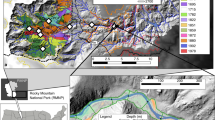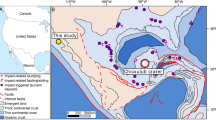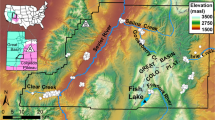Abstract
PROJECTIONS of the ecological effects of global climate change often include increased frequency and/or intensity of forest fires in regions of warmer and drier climate 1–3In addition to disturbing biological systems, widespread intense fires may influence the evolution of the physical landscape through greatly enhanced sediment transport4. Debris-flow to flood-streamflow sedimentation events following the 1988 fires in the Yellowstone National Park area (Wyoming and Montana, USA) have allowed us to examine the geomorphological response to fire in a mountain environment. Abundant analogous deposits in older alluvial fan sequences bear witness to past fire-related sedimentation events in northeastern Yellowstone, and radiocarbon dating of these events yields a detailed chronology of fire-related sedimentation for the past 3,500 years. We find that alluvial fans aggrade during periods of frequent fire-related sedimentation events, and we interpret these periods as subject to drought or high climatic variability. During wetter periods, sediment is removed from alluvial fan storage and transported down axial streams, resulting in floodplain aggradation. The dominant alluvial activity is strongly modulated by climate, with fire acting as a drought-actuated catalyst for sediment transport.
This is a preview of subscription content, access via your institution
Access options
Subscribe to this journal
Receive 51 print issues and online access
$199.00 per year
only $3.90 per issue
Buy this article
- Purchase on Springer Link
- Instant access to full article PDF
Prices may be subject to local taxes which are calculated during checkout
Similar content being viewed by others
References
Clark, J. S. Nature 334, 233–235 (1988).
Overpeck, J. T., Rind, D. & Goldberg, R. Nature 343, 51–53 (1990).
Romme, W. H. & Turner, M. G. Conserv. Biol. 5, 373–386 (1991).
Swanson, F. J. in Fire and Ecosystem Processes, USDA-Forest Service General Tech. Rep. WO-26 (eds Mooney, H. A., Bonnicksen, T. M., Christensen, N. L., Lotan, J. E. & Reiners, W. A.) 401–420 (1981).
Romme, W. H. & Despain, D. G. Bioscience 39, 695–699 (1989).
Ryder, J. M. Can. J. Earth Sci. 8, 279–298 (1971).
Wells, W. G. II in Debris Flows/Avalanches (eds Costa, J. E. & Wieczorek, G. F.) 105–114 (Geological Society of America, Boulder, 1987).
Pierson, T. C. & Costa, J. E. in Debris Flows/Avalanches (eds Costa, J. E. & Wieczorek, G. F.) 1–12 (Geological Society of America, Boulder, 1987).
Wells, S. G. & Harvey, A. M. Bull. geol. Soc. Am. 98, 182–198 (1987).
Collins, B. D. & Dunne, T. Earth Surface Processes and Landforms 13, 193–205 (1988).
Stuiver, M. & Reimer, P. J. Users Guide to the Programs CALIB & DISPLAY 2.1 (Quaternary Isotope Lab., Univ. of Washington, 1987).
Barrett, S. W. & Arno, S. F. in Univ. of Wyoming-Nat. Park Service Research Center 14th Annual Rep. (eds Boyce, M. S. & Plumb, G. E.) 131–133 (UW-NPS Research Center. Laramie, 1990).
Millspaugh, S. H. thesis, Univ. of Pittsburgh (1991).
Gennett, J. A. thesis, Univ. of Iowa (1977).
Barnosky, E. A. Historical Biology (in the press).
Lamb, H. H. Climate, Vol. 2 (Methuen, London, 1977).
Williams, L. D. & Wigley, T. M. L. Quat. Res. 20, 286–307 (1983).
Porter, S. C. Quat. Res. 26, 27–48 (1986).
Balling, R. C. Jr, Meyer, G. A. & Wells, S. G. Clim. Change (in the press).
LaMarche, V. C. Jr Science 183, 1043–1048 (1974).
LaMarche, V. C. Jr & Stockton, C. W. Tree-Ring Bull. 34, 21–45 (1974).
Briffa, K. R. et al. Nature 346, 434–439 (1990).
Laird, J. R. & Harvey, M. D. in Drainage Basin Sediment Delivery (ed. Hadley, R. F.) 165–183 (International Association of Hydrological Sciences, Wallingford, 1986).
Ewing, R. & Mohrman, J. in Symp. Proc. Headwaters Hydrology (eds Woessner, W. W. & Potts, D. F.) 213–222 (American Water Resources Association, Bethesda, Maryland, 1989)
Osborn, G. & Luckman, B. H. Quat Sci. Rev. 7, 115–128 (1988).
Knox, J. C. in Late-Quaternary Environments of the United States, Vol. 2 (ed. Wright, H. E. Jr) 26–41 (Univ. of Minnesota Press, Minneapolis, 1983).
Baker, R. G. in Late-Quaternary Environments of the United States, Vol. 2 (ed. Wright, H. E. Jr) 109–127 (Univ. of Minnesota Press, Minneapolis, 1983).
Meyer, G. A. & Wells, S. G. Geol. Soc. Am. Abstr. Progr. 23(4), 48 (1991).
Johansen, E. A. Geol. Soc. Am. Abstr. Progr. 23(5), A121 (1991).
Author information
Authors and Affiliations
Rights and permissions
About this article
Cite this article
Meyer, G., Wells, S., Balling, R. et al. Response of alluvial systems to fire and climate change in Yellowstone National Park. Nature 357, 147–150 (1992). https://doi.org/10.1038/357147a0
Received:
Accepted:
Issue Date:
DOI: https://doi.org/10.1038/357147a0
This article is cited by
-
Threat Perception and Adaptive Capacity of Natural World Heritage Site Management
Environmental Management (2023)
-
Elevational differences in hydrogeomorphic disturbance regime influence sediment residence times within mountain river corridors
Nature Communications (2019)
-
The Unquantified Risk of Post-Fire Metal Concentration in Soil: a Review
Water, Air, & Soil Pollution (2017)
-
Did fire play a role in formation of dinosaur-rich deposits? An example from the Late Cretaceous of Canada
Palaeobiodiversity and Palaeoenvironments (2013)
-
Anticipating Stream Ecosystem Responses to Climate Change: Toward Predictions that Incorporate Effects Via Land–Water Linkages
Ecosystems (2013)
Comments
By submitting a comment you agree to abide by our Terms and Community Guidelines. If you find something abusive or that does not comply with our terms or guidelines please flag it as inappropriate.



